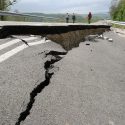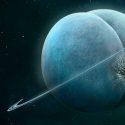A massive asteroid just hit Earth, right in the middle of the Atlantic Ocean. Thanks to NASA’s new infrared telescope, we were able to detect it and prepare for the collision. But our problems are not over yet. Because we now have a hypercane coming our way.
Wait, what is a hypercane? How could it be worse than an asteroid collision? And could it wipe out life across the planet?
Sixty-six million years ago, an asteroid struck Earth, causing the extinction of dinosaurs. But scientists have struggled to understand how the asteroid’s impact in one spot could cause the death of a species worldwide.
In 1995, MIT lecturer, Dr. Kerry Emanuel, proposed that the missing link could be a hypercane. This massive, dangerous storm would have the power to inject vast amounts of water and aerosols into the atmosphere, changing its chemistry and damaging the ozone layer. This would make the environment and climate unsuitable for life. But could a hypercane be worse than the hurricanes we’re used to? Would it be possible for us to survive a hypercane?
We’ll get to that a bit later. But let’s start from the beginning. A regular hurricane needs warm ocean waters and some kind of disturbance in the atmosphere. Think 26 ºC (80 ºF) for at least 45 m (15 ft) below the surface and lots of wind. This creates enough energy to speed up the water’s cycle of evaporating, rising, cooling, and condensing into thunderstorm clouds. The more the water evaporates, the faster the winds become, forming a swirling storm.
The Saffir-Simpson scale categorizes hurricanes based on their speed. It starts with a Category One hurricane, which ranges from 119 to 153 km/h (74 to 95 mph), and goes up to a Category Five, with win speeds of 251 km/h (156 mph) or stronger. To give you an idea of how bad that is, Hurricane Katrina, one of the deadliest in history, was a Category Five hurricane. It struck the United States Gulf Coast with winds of around 280 km/h (175 mph), leaving almost 2,000 people dead. And it came with a heavy price tag. It caused more than $125 billion in damages.
And a hypercane would be at least four times worse than that. According to Dr. Emanuel’s theory, it could have wind speeds of up to 804 km/h (500 mph), and the size would be almost 50 km (30 mi) tall and 4,023 km (2,500 mi) wide. That’s nearly as large as the U.S. So how could this happen? Time to go back to that asteroid.
If an asteroid as big as the one that killed the dinosaurs, which was 12 km (7.5 mi) wide, struck the middle of the Atlantic Ocean, it would heat the water up to 50 ºC (120 ºF). That amount of energy could form a hypercane in less than 48 hours. So brace yourself.
If the asteroid caught us off guard, and there were planes in the air, the hypercane could throw them off course as it formed. The pilots would need to hold on tight as they struggled through extreme turbulence to find a place to land.
For those on land, unless they had underground shelters, it would be nearly impossible to survive. And even if they did have shelters or were far away from the storm, they’d better have indoor agriculture set up and enough power to last for years to come. Earth, as we know, would be destroyed. The protective ozone layer that shields us from radiation would probably be gone, too.
If you dared to step outside, you’d need to be fully covered. Otherwise, you could develop skin cancer. And that’s the least of your problems. The intensity of the Sun’s radiation would make photosynthesis impossible for smaller plants. Without this process of converting light energy into chemical energy that fuels growth, they would eventually die. The food chain would then collapse. Herbivores would starve, and even though other animals could feed off their bodies for some time, the food supply would eventually end.
Luckily, hypercanes don’t seem to be anywhere in the near future. Although there were more than 19,000 near-Earth asteroids as of 2019, with an average of 30 discoveries each week, scientists are doing a good job monitoring threats to our planet. However, researchers agree that hurricanes will continue to get stronger and deadlier, primarily due to climate change. So it might be a good idea to start preparing for those. How about coming up with a plan to nuke a hurricane?
Sources
- “Tropical Cyclone Report” 2021. nhc.noaa.gov.
- “Meteorologists Answer Hurricane Questions | Scholastic”. 2021. scholastic.com.
- “NASA to build telescope for detecting asteroids that threaten Earth”. Paul, Voosen. 2019. Science | AAAS.
- “Dino-Killing Asteroid Hit Just The Right Spot To Trigger Extinction”. MICHELLE Z. DONAHUE. 2021. Science.
- “‘Hypercanes’ Could Lay Waste To Earth… And They May Have Killed The Dinosaurs”. Harrison, George. 2016. The Sun.
- “Could A 500 Mph “Hypercane” End Life As We Know It?”. Jhaneel Lockhart. 2017. Roaring Earth.



























